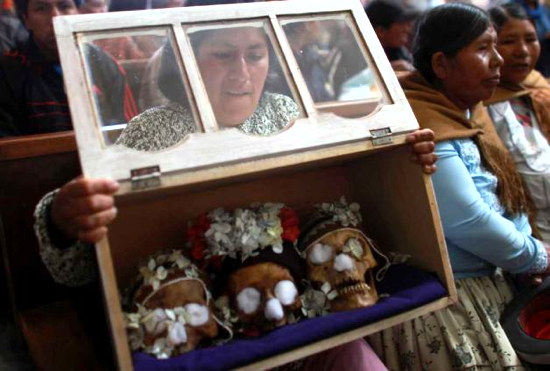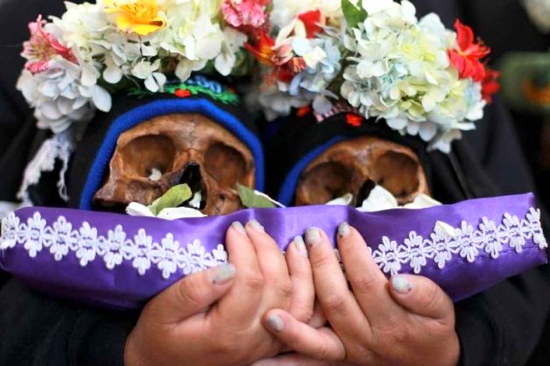
(above) A woman holds a set of decorated human skulls during Dia de los Natitas or Day of the Skulls festivities, before the start of a Mass at the church cemetery in La Paz, Bolivia, Tuesday Nov. 8, 2011. "Natitas," are human skulls from unnamed, abandoned graves or departed loved ones, that when cared for and decorated with flowers, cigarettes, coca leaves among other treats, are believed to protect one from evil. The Bolivian ritual marks the end of the All Saints holiday, but is not recognized by the Catholic church. Photo: Juan Karita / AP
Day of Skulls: Bolivians take skulls to cemetery
November 8, 2011 - Seattle PI (AP)
CARLOS VALDEZ, Associated Press
LA PAZ, Bolivia (AP) -- The human skulls brought to the cemetery in Bolivia's capital Tuesday were dressed in military hats, brightly colored Andean chuyo wool hats, adorned with flowers.
Bolivia's annual version of the Day of the Dead is a macabre mixture of Andean prehispanic beliefs and Roman Catholicism.
 (left) A man carries a decorated human skull before the start of a Mass celebrating Dia de los Natitas or Day of the Skulls, at the church cemetery in La Paz, Bolivia, Tuesday Nov. 8, 2011. "Natitas," are human skulls from unnamed, abandoned graves or departed loved ones, that when cared for and decorated with flowers, cigarettes, coca leaves among other treats, are believed to protect one from evil. The Bolivian ritual marks the end of the All Saints holiday, but is not officially recognized by the Catholic church. Photo: Juan Karita / AP
(left) A man carries a decorated human skull before the start of a Mass celebrating Dia de los Natitas or Day of the Skulls, at the church cemetery in La Paz, Bolivia, Tuesday Nov. 8, 2011. "Natitas," are human skulls from unnamed, abandoned graves or departed loved ones, that when cared for and decorated with flowers, cigarettes, coca leaves among other treats, are believed to protect one from evil. The Bolivian ritual marks the end of the All Saints holiday, but is not officially recognized by the Catholic church. Photo: Juan Karita / AP
The church considers it a pagan cult but chooses to recognize it as a way of retaining its influence in this indigenous-majority country.
An ancient Andean belief holds that people have seven souls, and one stays with the skull, anthropologists say. Believers think this soul has the power to visit people in their dreams, heal and provide protection.
Believers keep skulls, called "natitas," in their homes, giving them names and keeping them in glass cases or on makeshift altars.
For "Day of the Skull" celebrations, they dress them up and take them to the chapel at La Paz's main cemetery for Mass.
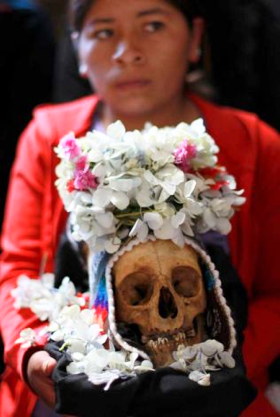 (right) A woman carries a decorated human skull the start of a Mass celebrating Dia de los Natitas or Day of the Skulls, at the church cemetery in La Paz, Bolivia, Tuesday Nov. 8, 2011. "Natitas," are human skulls from unnamed, abandoned graves or departed loved ones, that when cared for and decorated with flowers, cigarettes, coca leaves among other treats, are believed to protect one from evil. The Bolivian ritual marks the end of the All Saints holiday, but is not officially recognized by the Catholic church. Photo: Juan Karita / AP
(right) A woman carries a decorated human skull the start of a Mass celebrating Dia de los Natitas or Day of the Skulls, at the church cemetery in La Paz, Bolivia, Tuesday Nov. 8, 2011. "Natitas," are human skulls from unnamed, abandoned graves or departed loved ones, that when cared for and decorated with flowers, cigarettes, coca leaves among other treats, are believed to protect one from evil. The Bolivian ritual marks the end of the All Saints holiday, but is not officially recognized by the Catholic church. Photo: Juan Karita / AP
Homemaker Luisa Perez brought the skull that has accompanied her family for 24 years.
"To look after my house, to scare away thieves, to protect my family, that is why I venerate her," she said, adding that her mother found the skull in a cemetery.
The skulls are usually not of family members but of strangers, often recovered from cemeteries or purchased. Bolivian custom is to remove human remains for graves or tombs after eight years for the families to incinerate. But some remains go unclaimed.
(below) Catholic faithful leave the church cemetery carrying their decorated human skulls after attending a Mass during the Dia de los Natitas or Day of the Skulls festivities in La Paz, Bolivia, Tuesday Nov. 8, 2011. "Natitas," are human skulls from unnamed, abandoned graves or departed loved ones, that when cared for and decorated with flowers, cigarettes, coca leaves among other treats, are believed to protect one from evil. The Bolivian ritual marks the end of the All Saints holiday, but is not officially recognized by the Catholic church. Photo: Juan Karita / AP
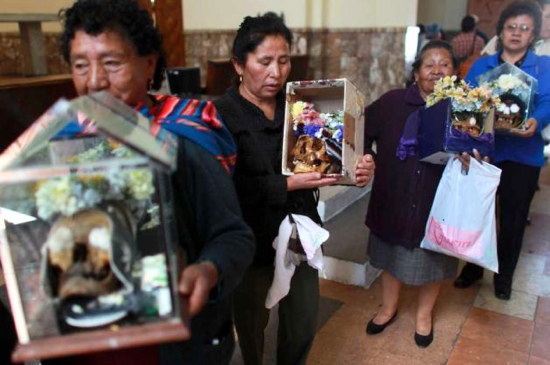
The Rev. Jaime Fernandez refused to bless the natitas this year at La Paz cemetery -- as has been done in the past -- but at the insistence of believers he agreed to say a short prayer so "their souls can rest."
(below) Catholic faithful with their decorated human skulls in hand wait for the start of a Mass celebrating Dia de los Natitas or Day of the Skulls, at the church cemetery in La Paz, Bolivia, Tuesday Nov. 8, 2011. "Natitas," are human skulls from unnamed, abandoned graves or departed loved ones, that when cared for and decorated with flowers, cigarettes, coca leaves among other treats, are believed to protect one from evil. The Bolivian ritual marks the end of the All Saints holiday, but is not officially recognized by the Catholic church. Photo: Juan Karita / AP
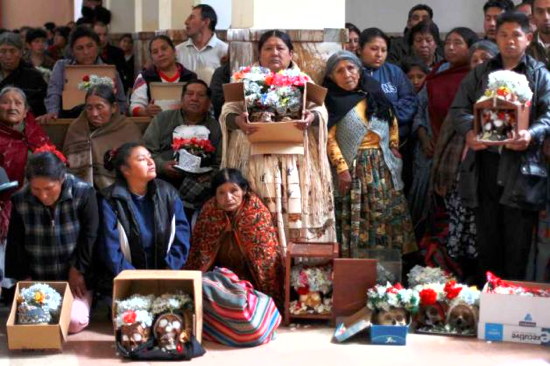
"They shouldn't bring them to the church. They shouldn't pull them from their tombs. They should leave them in peace," Fernandez said, praying over the skulls in Spanish and Aymara.
(below) Catholic faithful carry decorated human skulls during the Dia de los Natitas or Day of the Skulls, festivities, before the start of a Mass at the church cemetery in La Paz, Bolivia, Tuesday Nov. 8, 2011. "Natitas," are human skulls from unnamed, abandoned graves that when cared for and decorated with flowers, cigarettes, coca leaves among other treats, are believed to protect one from evil. The Bolivian ritual marks the end of the Catholic All Saints holiday, but is not recognized by the Catholic church. Photo: Juan Karita / AP
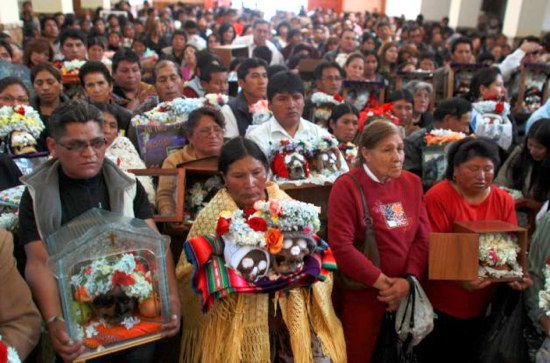
The belief in natitas is deeply rooted in poor neighborhoods and among rural migrants, but isn't popular among Bolivia's middle class.
Anthropologist Milton Eyzaguirre said that in the Andean world death is another dimension of life, and a time spent in contact with spirits is necessary.
(below) A woman holds a trio of decorated human skulls during Dia de los Natitas or Day of the Skulls festivities, before the start of a Mass at the church cemetery in La Paz, Bolivia, Tuesday Nov. 8, 2011. "Natitas," are human skulls from unnamed, abandoned graves or departed loved ones, that when cared for and decorated with flowers, cigarettes, coca leaves among other treats, are believed to protect one from evil. The Bolivian ritual marks the end of the All Saints holiday, but is not recognized by the Catholic church. Photo: Juan Karita / AP
